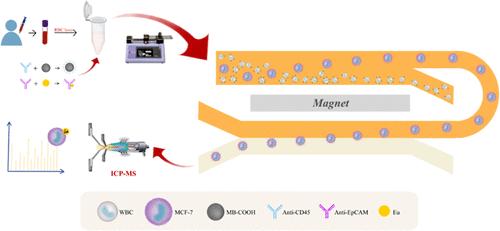易级联负磁泳芯片结合ICP-MS高效分选和在线检测循环肿瘤细胞
IF 6.7
1区 化学
Q1 CHEMISTRY, ANALYTICAL
引用次数: 0
摘要
循环肿瘤细胞(CTCs)的分离和检测对肿瘤的早期诊断和预后具有重要意义。负磁泳分选是一种无标签的方法,可以方便地富集完整的、有活力的ctc,但它难以满足高通量分离和直接下游分析的需求。本研究制作了一种简易级联负磁泳微流控芯片,并将其与电感耦合等离子体质谱(ICP-MS)在线耦合,用于血液样品中稀有ctc的快速分离和检测。该芯片由两部分组成:负磁泳分选区和负磁泳相转移区。在分选区,分散在生物相容性铁磁流体中的抗cd45磁珠(mb)标记的白细胞被磁性引力去除,而抗epcam - eu标记的CTCs则被磁性排斥力迁移到相转移区;在相转移区,由于磁流体与PBS缓冲液形成稳定的层流,ctc在磁斥力和惯性升力的双重作用下迁移到PBS中,并在线引入ICP-MS进行检测。该装置能以100 μL min-1的高通量富集CTC,具有直接下游分析和再培养的能力(细胞存活率为99.27%)。将该方法应用于10例诊断为各种癌症的临床真实血液样本中CTCs的检测,检出率为100%,为临床罕见CTCs的检测提供了一种简便、高效的方法。本文章由计算机程序翻译,如有差异,请以英文原文为准。

Facile Cascaded Negative Magnetophoresis Chip Combined with ICP–MS for Efficient Sorting and Online Detection of Circulating Tumor Cells
The isolation and detection of circulating tumor cells (CTCs) play a significant role in early cancer diagnosis and prognosis. Negative magnetophoresis sorting is a label-free method, providing easy access to enrich intact and viable CTCs, but it struggles to meet the demands of high-throughput separation and direct downstream analysis. In this work, a facile cascaded negative magnetophoresis microfluidic chip was fabricated and online coupled to inductively coupled plasma mass spectrometry (ICP–MS) for the rapid separation and detection of rare CTCs in blood samples. The chip consisted of two parts: a negative magnetophoresis sorting zone and a negative magnetophoresis phase-transfer zone. In the sorting zone, WBCs labeled with anti-CD45-magnetic beads (MBs) dispersed in biocompatible ferrofluid were removed by magnetic attractive force, while CTCs labeled with anti-EpCAM-Eu migrated into the phase-transfer zone by magnetic repulsive force; in the phase-transfer zone, due to the stable laminar flow formed by the magnetic fluid and PBS buffer, CTCs migrated into the PBS under both the magnetic repulsive force and inertial lift force and online introduced into ICP–MS for detection. This device can achieve CTC enrichment at a high throughput of 100 μL min–1 and has the capability for direct downstream analysis and recultivation (cell viability of 99.27%). The method was applied for the detection of CTCs in real clinical blood samples from 10 patients diagnosed with various cancers, and the detection rate was 100%, providing a simple and efficient approach for clinical detection of rare CTCs.
求助全文
通过发布文献求助,成功后即可免费获取论文全文。
去求助
来源期刊

Analytical Chemistry
化学-分析化学
CiteScore
12.10
自引率
12.20%
发文量
1949
审稿时长
1.4 months
期刊介绍:
Analytical Chemistry, a peer-reviewed research journal, focuses on disseminating new and original knowledge across all branches of analytical chemistry. Fundamental articles may explore general principles of chemical measurement science and need not directly address existing or potential analytical methodology. They can be entirely theoretical or report experimental results. Contributions may cover various phases of analytical operations, including sampling, bioanalysis, electrochemistry, mass spectrometry, microscale and nanoscale systems, environmental analysis, separations, spectroscopy, chemical reactions and selectivity, instrumentation, imaging, surface analysis, and data processing. Papers discussing known analytical methods should present a significant, original application of the method, a notable improvement, or results on an important analyte.
 求助内容:
求助内容: 应助结果提醒方式:
应助结果提醒方式:


